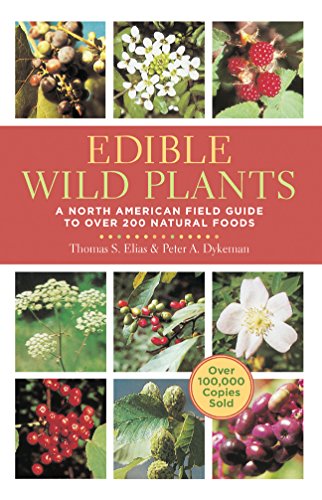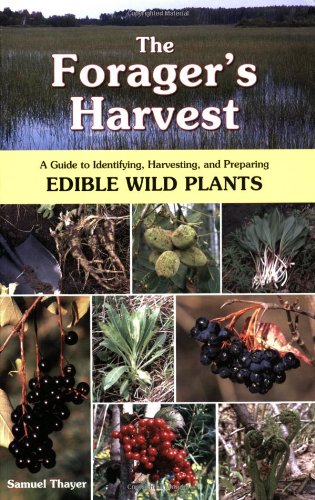How to buy the best wild edibles field guide?
When you want to find wild edibles field guide, you may need to consider between many choices. Finding the best wild edibles field guide is not an easy task. In this post, we create a very short list about top 10 the best wild edibles field guide for you. You can check detail product features, product specifications and also our voting for each product. Let’s start with following top 10 wild edibles field guide:
1. National Audubon Society Field Guide to North American Mushrooms (National Audubon Society Field Guides)
Feature
COLOR photographsDescription
The most comprehensive field guide available to North American mushrooms--a must-have for any enthusiast's day pack or home library--from the go-to reference source for over 18 million nature lovers.Featuring a durable vinyl binding and over 700 full-color identification photographsorganized visually by color and shape, the National Audubon Society Field Guide to North American Mushroomsis the perfect companion for any mushroom hunting expedition. Each species is accompanied by a detailed physical description, information on edibility, season, habitat, range, look-alikes, alternative names, and facts on edible and poisonous species, uses, and folklore. A supplementary section on cooking and eating wild mushrooms, and illustrations identifying the parts of a mushroom, round out this essential guide.
2. Bushcraft 101: A Field Guide to the Art of Wilderness Survival
Feature
Bushcraft 101 A Field Guide to the Art of Wilderness SurvivalDescription
A New York Times Bestseller in Sports and Travel!The ultimate resource for experiencing the backcountry!
Written by survivalist expert Dave Canterbury, Bushcraft 101 gets you ready for your next backcountry trip with advice on making the most of your time outdoors. Based on the 5Cs of Survivability--cutting tools, covering, combustion devices, containers, and cordages--this valuable guide offers only the most important survival skills to help you craft resources from your surroundings and truly experience the beauty and thrill of the wilderness. Inside, you'll also discover detailed information on:
- Choosing the right items for your kit.
- Manufacturing needed tools and supplies.
- Collecting and cooking food.
- Protecting yourself from the elements.
3. Edible Wild Plants: A North American Field Guide to Over 200 Natural Foods
Feature
Edible Wild Plants A North American Field Guide to Over 200 Natural FoodsDescription
Planning an outdoor adventure? Make sure to consult this information-packed and photo-filled North American field guidearranged by season and regionbefore you go!
Already a huge success in previous editions, this must-have field guide now features a fresh new cover, as well as nearly 400 color photos and detailed information on more than 200 species of edible plants all across North America.
With all the plants conveniently organized by season, enthusiasts will find it very simple to locate and identify their desired ingredients. Each entry includes images, plus facts on the plants habitat, physical properties, harvesting, preparation, and poisonous look-alikes. The introduction contains tempting recipes and theres a quick-reference seasonal key for each plant.
4. Edible Wild Plants: Eastern/Central North America (Peterson Field Guides)
Feature
Houghton Mifflin Edible Wild Plants: East & Cen by Peterson Field Guide - 0-395-92622-XDescription
5. The Forager's Harvest: A Guide to Identifying, Harvesting, and Preparing Edible Wild Plants
Feature
Winner of the 2006 Midwest Book Award!218 color photos, demonstrating each edible part in the proper stage of harvest, plus showing important identifying features
Step-by-step tutorial to positive plant identification
Photos and text comparing potentially confusing plants
Thorough discussion on how to gather and use the plants
Description
A guide to 32 of the best and most common edible wild plants in North America, with detailed information on how to identify them, where they are found, how and when they are harvested, which parts are used, how they are prepared, as well as their culinary use, ecology, conservation, and cultural history.
6. Edible Wild Plants: A Folding Pocket Guide to Familiar North American Species (A Pocket Naturalist Guide)
Feature
An introduction to familiar North American species. Highlights over 100 familiar species and includes a section on dangerous poisonous plants. Beautifully illustrated.Laminated for durability. A great source of portable information. Ideal for field use by novices and experts alike.
Illustration count: 100. Size (folded): 8.25 x 3.5 in.. Weight: 1 oz..
Author: James Kavanagh. Illustrations: Raymond Leung. From Waterford Press.
Description
Some wild edible plants have poisonous look-alikes, and it is important to know the difference when harvesting. Edible Wild Plants is a simplified guide to familiar and widespread species of edible berries, nuts, leaves and roots found in North America. This beautifully illustrated guide identifies over 100 familiar species and includes information on how to harvest their edible parts. It also includes a section on dangerous poisonous plants to avoid that have contact poisons that can blister skin. This convenient guide is a portable source of practical information and ideal for field use.7. The Scout's Guide to Wild Edibles: Learn How To Forage, Prepare & Eat 40 Wild Foods
Feature
St Lynn s PressDescription
The Scouts Guide to Wild Edibles is the winner of the Nature Guidebook category of the 2017 National Outdoor Book Awards (NOBA). Ever seen a tasty-looking plant or mushroom in a yard or forest but werent sure if it would taste goodor even be edible? In The Scouts Guide to Wild Edibles, renowned forager Mike Krebill profiles 40 widely-found edible wild plants and mushrooms of North America, in a guide small enough to fit right in a pocket. The author offers clear color photos and positive-ID tips for each plant, along with lip-smacking recipes and engaging projects and activities for all skill levels. The Scouts Guide will help foragers locate, identify and safely enjoy wild edibles with the added satisfaction of knowing exactly where their food came from.8. The Complete Guide to Edible Wild Plants
Feature
In-depth Guide to edible plantsIdentifies poisons and edible plant characteristics
Over 100 color photos
Description
Anyone who has spent serious time outdoors knows that in survival situations, wild plants are often the only sustenance available. The proper identification of these plants can mean the difference between survival and death. This book describes habitat and distribution, physical characteristics, and edible parts of wild plants the key elements of identification. Hugely important to the book are its color photos. There are over one hundred of them, further simplifying the identification of poisonous and edible plants. No serious outdoors person should ever hit the trail without this book and the knowledge contained within it. Specifications:- number of pages: 160- size: 6" x 9".9. Wild Edibles: A Practical Guide to Foraging, with Easy Identification of 60 Edible Plants and 67 Recipes
Feature
North Atlantic BooksDescription
In this field guide to foraging wild edible plants, Sergei Boutenko (son of raw-food guru Victoria Boutenko) explores the health benefits of wild-harvested food, explains how to safely identify trailside weeds, herbs, fruits, and greens that grow worldwide, and shares his delicious, nutrient-dense recipes.Sergei Boutenko has been gathering wild plants since he was 13, when, early on in a 6-month hike from Mexico to Canada, he and his raw-food family ran out of provisions and turned to foraging for survival in the wild. Back in civilization, Boutenko was dismayed by the inferior quality of store-bought food and industrial agriculture, and began to regularly collect wild plants near his home and on his travels. Now, in Wild Edibles, he shares knowledge gleaned from years of live-food wildcrafting and thriving in harmony with nature.
This practical guide to plant foraging gives hikers, backpackers, raw foodists, gardeners, chefs, foodies, DIYers, survivalists, and off-the-grid enthusiasts the tools to identify, harvest, and prepare wild edible plants. The book outlines basic rules for safe wild-food foraging and discusses poisonous plants, plant identification protocol, gathering etiquette, and conservation.
Boutenko explores in detail the many rewards of eating wild flora: environmental protection, sustainability, saving money, economic self-sufficiency, and healthy living. He draws on thoroughly researched nutrition science to make a compelling case for the health benefits of a diverse, local-food diet that includes wild greens.
The majority of the 60 edible plants described in this field guide can be found worldwide, including common-growing trees. Over 300 color photos make plant identification easy and safe. A chapter containing 67 high-nutrient vegan recipesincluding green smoothies, salads and salad dressings, spreads and crackers, main courses, juices, and sweetsprovides inspiration to join Sergei on the trail to radiant health.
Wild Edibles: A Practical Guide to Foraging, with Easy Identification of 60 Edible Plants and 67 Recipeshas taught me that my backyard is full of free food! Way to go, Sergei. John Mackey, CEO of Whole Foods Market
10. Mushrooming without Fear: The Beginner's Guide to Collecting Safe and Delicious Mushrooms
Feature
Alexander SchwabMushrooming Without Fear
Plants













Recent Comments